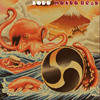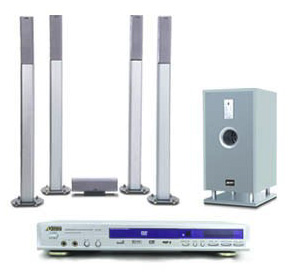![[SoundStage!]](../sslogo3.gif) Surrounded! Surrounded!Back Issue Article |
||||
March 2004 Aspire Digital AD-1100 Plus 5.1-Channel System
Most seasoned audiophiles take great pleasure in helping friends and family choose home-entertainment systems. The process of helping to purchase and set up a stereo or surround-sound rig is a way to share your hobby, not to mention the fun that will ensue once the new owner is enjoying it. These days the average Joe -- which defines the largest segment of the market for electronics -- wants a full 5.1-channel system. Whether for music or to provide a little more excitement when watching a DVD on Saturday night, most buyers have two primary requirements: the system must have more enveloping sound than their TV -- meaning surround sound -- and it must be affordable. When entering into the consultant role, an audiophile has to transition -- what may be affordable gear to us is typically a ridiculous proposition to others. The first step in assessing someone’s needs and wants when it comes to a home-entertainment system involves finding out two things: what the performance expectations are for the room where it will be placed, and of course the inevitable "budget question." There’s always the chance that you’ll be faced with the challenge of building a system "that sounds just like yours for $1000." That’ll be a problem when your rig costs a tidy ten times more. Nonetheless, I’ve amassed a number of recommendations for all types of needs and budgets, as I’m sure most of you have. For just under $1000 there are a variety of conceivable stereo systems that sound like they cost much more. The proposition gets more challenging when surround sound enters the equation but the budget stays the same. Still, there are products that can deliver at just about any price point. Looking at the SoundStage! Network’s 2004 CES coverage, you’ll find cool DVD players for under $100 and full 5.1-channel speaker systems for under $600 -- and these products deliver performance well beyond what you would expect at their prices. I was shocked to hear the sound that Hsu Research was producing for under a grand from their Ventriloquist 6.1-channel speaker system. But what if a grand is still too much? What if $800 is out of the question? And what will you recommend if $600 breaks the budget? What would you do to get surround sound into someone’s home for under $500? And we’re not just talking about speakers but a DVD player and something to power it all, too. And while you’re at it, include the cables and accessories. Santa Maria! When faced with such a challenge from here on out, you can say, "No problem. I can help." And then remember you read this article. The AD-1100 Plus The list price of the Aspire Digital AD-1100 Plus is $399 USD. A quick search on Yahoo Shopping will turn up numerous retailers selling the system for considerably less. I'm talking just under three bills if you’re careful. For that amount of money you get a lot of stuff: four shielded tower speakers each with two 2" drivers; a shielded center-channel speaker with the same driver complement as the mains and surrounds; a progressive-scan DVD player with built-in Dolby Digital and DTS decoders, not to mention S-video and component outputs; and a 8" 150W powered subwoofer that also contains the rest of the system’s amplification (650W total system power as rated by the manufacturer). You also get remote control of all functions, wiring to hook it all up, and some doggoned big boxes. We’re not talking about a home-theater-in-the-box that you can fit under an arm while you talk on your cell phone with the other hand. This package is more substantial than you’d think. OK, I know you’re waiting for the section that tells you where the compromises are. Here's the biggie: The Aspire Digital system is almost all plastic. It is colored to look like aluminum, but there’s no metal in sight. The speakers’ cabinetry is extremely lightweight in its overall construction, although the speakers do include some heavy steel bases and surprisingly substantial floor spikes that keep them steady on carpet. Speaker connectors on the outputs and inputs are spring clips, and the speaker grilles are non-removable. Those points of construction may not be overly crucial though -- and dwelling on them may be missing the point. Some of the same criticisms can be leveled against products costing far more than the few bills you’ll lay down here. I mean heck, you can go to Best Buy and spend $200 on a gaudy-looking boom box. With Aspire Digital you can get an entire surround system for just $50 more than that. Let’s keep some perspective here. Setting ‘er up The setup of the AD-1100 Plus couldn’t be easier. A set of six-channel outputs connects the DVD player to the subwoofer/amplifier system, and all of the speakers hook into the sub via the provided speaker wire. The DVD player has an onscreen menu for programming the system, which you can accomplish in just a few moments with the remote. The only setup detail of note is that both the DVD player and the subwoofer need to be within clear shot of the viewing/listening position; each has it’s own remote control and remote sensor, one for DVD controls and one for all of the amplifier functions such as volume. It’s a shame these couldn't be combined into one unit for greater ease of use. What’ll you hear? A heck of a lot more than you’d expect. The subwoofer belts out some real bass compared with, say, a boom box. The low frequencies present on Pink Floyd’s The Dark Side of the Moon [Capital CDP 7243] fairly filled my large room in two-channel mode. Granted, the bass wasn’t visceral, but it did walk a fairly tight line between augmenting the main channels and providing real sub-bass. I’d estimate response down to the upper-30Hz or lower-40Hz range -- sufficient to give a firmer foundation to music than many $500 minimonitors can provide. The upper frequencies don’t sound bright or etched; rather they err on the side of caution and roll off at the very top end of the spectrum. This is welcome when listening to some film soundtracks and many older CDs. Fleetwood Mac’s The Dance on DVD-Video had a pleasant sound that communicated the music effectively. The overall soundstage was bigger than you’d expect -- the Aspire system managed output levels that had sufficient loudness for rock, country, or jazz.
Don’t expect to shake the floorboards or hear every last molecule of air around instruments. Do expect to have much more dynamic range than you would have with any TV, a reasonably coherent 360-degree soundfield, and even a Karaoke function for those wild parties on the weekend. And don’t forget that having surround sound lets you hear movies in a way that makes them much more enjoyable than with two channels of equal performance. Wrap ‘er up and take her home The Aspire Digital AD-1100 Plus is not a giant killer that will compete with an amplifier, source, and speakers like the ones we usually write about on SoundStage!. But then again it’s not meant to, either. It does more than many of the home-theater-in-a-box systems that come in a container no larger than a couple of briefcases stacked atop each other. It also drastically improves upon the sound you’d get from your TV alone. What’s not to like about a system that for less than a few hundred dollars can give your family more enjoyment from CDs and movies -- not to mention music concerts on DVD-Video? I like the fact that for the price of a few trips out to the theater (and the meal that necessarily has to accompany them), a system exists that I can recommend. And now you can, too. ...Jeff Fritz
|
||||
|
||||
![[SoundStage!]](../sslogo3.gif) All Contents All ContentsCopyright © 2004 SoundStage! All Rights Reserved |
 There’s music you listen to
for pleasure, music you appreciate for its artistic intent and the talent of the
musicians, and pure demo material to test or show off your system. Kodo, the Japanese
percussionists that have created some of most rhythmic sounds to yet grace the SACD
format, creates music that falls into all three categories. Their Mondo Head can be
heard at consumer-electronics shows worldwide -- played by manufacturers wishing to
showcase a system’s dynamic punch, transient snap, and deep-bass capabilities. In
multichannel mode, these audiophile attributes are amplified even more.
There’s music you listen to
for pleasure, music you appreciate for its artistic intent and the talent of the
musicians, and pure demo material to test or show off your system. Kodo, the Japanese
percussionists that have created some of most rhythmic sounds to yet grace the SACD
format, creates music that falls into all three categories. Their Mondo Head can be
heard at consumer-electronics shows worldwide -- played by manufacturers wishing to
showcase a system’s dynamic punch, transient snap, and deep-bass capabilities. In
multichannel mode, these audiophile attributes are amplified even more. Playing around with the
speaker setup did produce good imaging. I found that placing the speakers closer together
than normal, just a couple of feet on either side of my monitor, yielded the best results.
You won’t hear as wide a stage as you would with a decent set of bookshelf speakers,
but if you’re looking to expand upon the sound you’d hear from any TV while
locking together the front stage and anchoring the fairly clear vocals dead center,
you’ll not be disappointed. The center-channel speaker needs to be set to fire
directly at the listening position. Off-axis you’ll lose clarity and focus, but
directly on-axis, with simple vocals like those on Norah Jones’ Live in New
Orleans, the sound can be quite satisfying.
Playing around with the
speaker setup did produce good imaging. I found that placing the speakers closer together
than normal, just a couple of feet on either side of my monitor, yielded the best results.
You won’t hear as wide a stage as you would with a decent set of bookshelf speakers,
but if you’re looking to expand upon the sound you’d hear from any TV while
locking together the front stage and anchoring the fairly clear vocals dead center,
you’ll not be disappointed. The center-channel speaker needs to be set to fire
directly at the listening position. Off-axis you’ll lose clarity and focus, but
directly on-axis, with simple vocals like those on Norah Jones’ Live in New
Orleans, the sound can be quite satisfying.